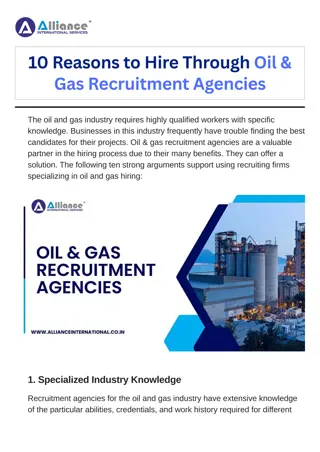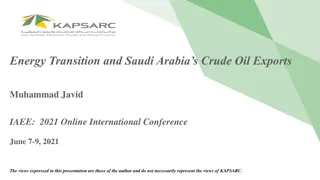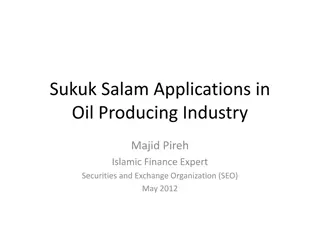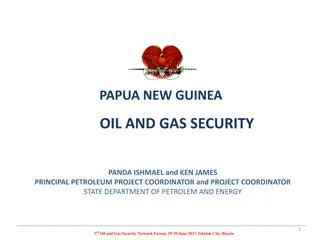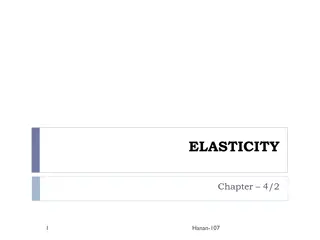Understanding the Impact of Oil Price Downturns on the Energy Industry
Recent discussions at the PLANO Executive Night Seminar focused on the implications of oil price fluctuations on the energy sector. The session highlighted the challenges faced by highly leveraged companies in the wake of decreased oil prices, emphasizing the need for strategic financial management and risk mitigation strategies. The presentation also delved into the shifting dynamics of the industry, exploring potential options for companies to navigate uncertain market conditions.
Download Presentation

Please find below an Image/Link to download the presentation.
The content on the website is provided AS IS for your information and personal use only. It may not be sold, licensed, or shared on other websites without obtaining consent from the author. Download presentation by click this link. If you encounter any issues during the download, it is possible that the publisher has removed the file from their server.
E N D
Presentation Transcript
Oil Price Downturns: Some Bankruptcy Thoughts PLANO Executive Night Seminar April 16, 2015 Presented by Louis M. Phillips Rick M. Shelby Attorneys, Gordon Arata Law Firm New Orleans, Louisiana
Open Panel Discussion TOPICS 1. Oil Price Recent Trends and Consequences 2. Reorganization 3. Bankruptcy Key Concepts 4. Recent Case Study ATP
Recent Oil Price Implications Following the 2008 recession, strong oil prices and the natural gas boom attracted increasing amounts of capital into the E&P industry. The high oil prices led to increased revenues and asset values for the E&P industry supporting higher loan-to-value ratios. Reserve-based revolving credit facilities and second lien debt became more accessible for industry participants to pursue E&P opportunities and smaller industry entrants could take advantage of sunset properties that were otherwise unattractive to larger E&P companies. In addition, E&P companies became creative with royalty/production payment incentives offered to the capital market.
Recent Oil Price Implications The recent collapse in oil price has resulted in big cash problems for highly leveraged companies. Asset values decline and without sufficient revenue to fund operations and service debt, these companies are at the risk of default. Scheduled (or unscheduled) borrowing base redeterminations likely reveal deficiencies that must be corrected. Furthermore, despite the decrease in oil prices, current operational costs have not declined largely due to increased scrutiny of the industry post-Deepwater Horizon.
Additional Financial Pressures Recently, the oil and gas industry has also been forced to address unfunded decommissioning obligations and related changes in regulations. Deepwater Horizon increased insurance and financial assurance requirements; created the need for increased emphasis on safety and SEMs program; resulted in a corresponding drilling moratorium temporarily halting development opportunities The extreme of how bad the problem can get was recently demonstrated in the ATP bankruptcy caused largely by a combination of many of these concepts Royalty assignments and funding operations with debt P&A funding and related bonding requirements Drilling Moratorium suit against United States Creation of Risk Management Program Recent NTLs re: bonding
Potential Options Lean and Mean lower leveraged companies with stable balance sheets will see decreased revenues and focus on their spending flexibility; these companies will be best positioned for future growth when assets are shed at lower oil prices and oil prices rebound; executives should focus on projections Loan Workouts higher leveraged companies who are in default may seek forbearance agreements and implement cost-cutting strategies including dumping assets Reorganization bankruptcy may offer the ability to restructure debt consistent with the assets current value and at potentially lower interest rates; additional benefits include rejecting unfavorable agreements, discharging debt and maintaining current operations Liquidation as a last resort, liquidate assets to pay debt
Chapter 11 Reorganization Discussion Chapter 11 Benefits Provides the opportunity for a fresh start Treatment and classification of claims Automatic stay Preservation of property for the benefit of secured creditors Assumption and/or rejection of executory contracts Abandonment of burdensome property Continued operation of businesses Chapter 11 Basic Requirements Monthly Reporting Filing of Schedules and Statements Employment of Professionals Bankruptcy Approval of Settlements
Key Concept: Property of the Estate 11 U.S.C. 541 an estate is created by commencement of the bankruptcy case All legal or equitable interests of the debtor in property as of the commencement of the case NOTE: Section 541 does not define the interests. The question of whether or not the debtor has an interest in property and the determination of the nature and extent of interest is resolved under nonbankruptcy law.
Classification of Claims 11 USC 1122 Secured evidence of an interest in collateral LOWLA and 11 USC 546(b) and perfection of security interest RS 9:4863(A) property subject to LOWLA privilege RS 9:4865 recordation/enforcement/lis pendens deadlines Endeavor Operating Corp. creditors argue lack of perfection Unsecured Administrative Priority General Unsecured Equity Interests New Value Exception
Bankruptcy Principles to Shed Liabilities Abandonment of Burdensome Assets 11 U.S.C. 554 Administrative burden no value/no benefit Midlantic Nat l Bank v. New Jersey Dept. of Environmental Protection, 474 U.S. 494 (1986) = a debtor cannot abandon property that would violate decommissioning regulations reasonably designed to protect the public health or safety from identified hazards.
ATP Bankruptcy Case Background Case No. 12-36187 (Isgur) S.D. Texas ATP sought Chapter 11 bankruptcy protection in August 2012, citing dramatically reduced cash flows from the deepwater drilling moratorium. Much of ATP s development and production was funded by debt. ATP was exempt from supplemental bonding until July 31, 2012 when DOI revoked ATP s exempt status. ATP filed for bankruptcy in August 2012, leaving its assessed decommissioning liabilities un-bonded
ATP Moved to Shed Residual Decommissioning Liabilities pursuant to Section 554 The ATP court permitted abandonment in light of Midlantic In re ATP Oil & Gas Corp., 2013 WL 3157567, (Bankr. S.D. Tex. June 19, 2013) = Midlantic did not hold that a debtor may abandon property where abandonment would be consistent with and perhaps in furtherance of an environmental regulatory scheme.
Regulatory decommissioning liabilities 250.1701 Who must meet the decommissioning obligations in this subpart? (a) Lessees and owners of operating rights are jointly and severally responsible for meeting decommissioning obligations for facilities on leases, including the obligations related to lease-term pipelines, as the obligations accrue and until each obligation is met. 250.1702 When do I accrue decommissioning obligations? You accrue decommissioning obligations when you do any of the following: (a) Drill a well; (b) Install a platform, pipeline, or other facility; (c) Create an obstruction to other users of the OCS; (d) Are or become a lessee or the owner of operating rights of a lease on which there is a well that has not been permanently plugged according to this subpart, a platform, a lease term pipeline, or other facility, or an obstruction; (e) Are or become the holder of a pipeline right-of-way on which there is a pipeline, platform, or other facility, or an obstruction; or (f) Re-enter a well that was previously plugged according to this subpart.
Residual liability under 30 CFR 556.62: You do not gain a release from any accrued obligation under your lease or the regulations by assigning your record title interest or transferring your operating rights in the lease. You are jointly and severally liable for the performance of each nonmonetary obligation under the lease and under the with each prior lessee and with each operating rights owner holding an interest at the time the obligation accrued, unless this chapter provides otherwise. Sublessees and operating rights owners are jointly and severally liable for the performance of each nonmonetary obligation under the lease and under the regulations in this chapter to the extent that: The obligation relates to the area embraced by the sublease; and Those owners held their respective interest at the time the obligation accrued
IN RE: ATP OIL & GAS CORPORATION, Debtor(s). Motion to Abandon Gomez Properties The Court is not unsympathetic to Anadarko. It may be forced to bear a substantial cost as a result of ATP s financial woes. Nevertheless, like many things in a bankruptcy case, the cost that Anadarko may bear is a reflection of the credit risk it took. Anadarko sold a portion of the Gomez Properties to ATP, and required ATP to bear the financial burden of plugging and abandonment in accordance with applicable federal law. This unfortunate position is no different from that of any other creditor that relies on the promise of performance from an eventually failed entity. In re ATP Oil & Gas Corp., 2013 WL 3157567, (Bankr. S.D. Tex. June 19, 2013)
Anadarkos Relief? DOI, ATP and Anadarko ultimately settled with Anadarko receiving proceeds of ATP s $3 million area wide bond but responsible for decommissioning properties The Anadarko decommissioning settlement agreement also preserved any administrative expense claim arising out of the maintenance and decommissioning of the platform and MC 711 Lease. Anadarko filed a proof of claim on 1/6/2014 for $115,217,808 of projected maintenance and decommissioning costs.
19 Donna Dixon 2014 OCS Workshop
https://encrypted-tbn0.gstatic.com/images?q=tbn:ANd9GcSlEyczuNkA8yvjB35OqZRljOSzlGAtkkvGJAPSo0nJW97QcwgYhttps://encrypted-tbn0.gstatic.com/images?q=tbn:ANd9GcSlEyczuNkA8yvjB35OqZRljOSzlGAtkkvGJAPSo0nJW97QcwgY Executory Contracts Countryman definition Continued performance of contracts & cure reqs. 11 USC 365(d)(4) unexpired leases of nonresidential real property ATP moves to reject OCS leases and classify carved out interests (ORR) as property of the estate DOI supports ATP s position agreeing that OCS leases are merely contractual leasehold rights
Bankruptcy Safe Harbors Section 541(d) equitable title Section 541(b)(4) farmouts Section 541(b)(4)(B) production payments production payment a term overriding royalty satisfiable in cash or in kind (A) contingent on the production of a liquid or gaseous hydrocarbon from particular real property; and (B) from a specified volume, or a specified value, from the liquid or gaseous hydrocarbon produced from such property, and determined without regard to production costs. 11 U.S.C. 101(42A).
Joint Operating Agreements Executory Contracts severability of provisions Recordation of JOA for perfection of lien provisions Prior to assumption/rejection JOA only enforceable by debtor not against the debtor Ipso Facto Clauses automatic stay Enforcement of obligations or termination No automatic right to offset JOA may call for interim committee to operate Issue non-consent by a debtor party to the JOA and then subsequent rejection of the JOA
Mineral Interest Owners Prepetition royalty claim unsecured claim Exceptions: lease language, other agreements, statutory entitlements Lease termination rights Automatic stay State law rights statutory liens Interim bankruptcy court approval to pay prepetition royalties to prevent harm to the estate
Chapter 11 Confirmation Disclosure Statement Section 1125 Adequate information Approval of Plan of Reorganization Section 1129 Impairment of Claims Fair and Equitable test secured creditors receive value of collateral Absolute priority rule treatment of equity interests



